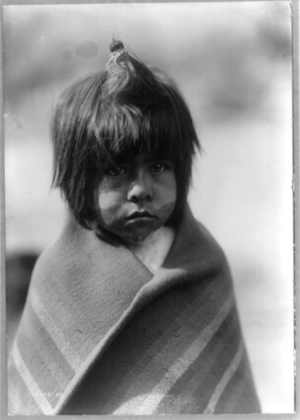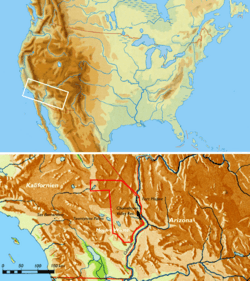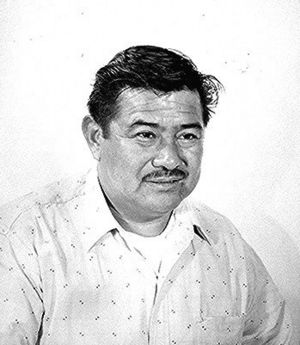Chemehuevi facts for kids
|
Chemehuevi lands in California and Arizona
|
|
| Total population | |
|---|---|
| 2010: 1,201 alone and in combination | |
| Regions with significant populations | |
( |
|
| Languages | |
| English, Colorado River Numic (ISO 639-3, ute) | |
| Religion | |
| Native American Church, Sun Dance, traditional tribal religion, Christianity, Ghost Dance | |
| Related ethnic groups | |
| Southern Paiute people |
The Chemehuevi are an Indigenous people who have lived in the Great Basin area for a very long time. They are the southernmost group of the Southern Paiute.
Today, many Chemehuevi people are part of official federally recognized tribes in the United States. These include:
- Colorado River Indian Tribes
- Chemehuevi Indian Tribe of the Chemehuevi Reservation
- Morongo Band of Mission Indians
- Cabazon Band of Mission Indians
- Agua Caliente Band of Cahuilla Indians
- Torres-Martinez Desert Cahuilla Indians
- Twenty-Nine Palms Band of Mission Indians of California
Some Chemehuevi are also members of the Soboba Band of Luiseño Indians, which mainly includes people from the Cahuilla and Luiseño tribes.
Contents
What Does "Chemehuevi" Mean?
The name "Chemehuevi" has a few different meanings. Some people think it comes from the Mojave language and means "those who play with fish." Others believe it's a Quechan word meaning "nose-in-the-air-like-a-roadrunner."
The Chemehuevi people have their own names for themselves. They call themselves Nüwüwü, which means "The People." If they are talking about one person, they say Nüwü. Another name they use is Tantáwats, meaning "Southern Men."
The Chemehuevi Language
The Chemehuevi language is part of the Colorado River Numic language family. This language is also a branch of the larger Uto-Aztecan language family.
In the early 1900s, linguists like John P. Harrington and Carobeth Laird wrote down the Chemehuevi language. Later, in the 1970s, another linguist named Margaret L. Press studied it more deeply. She made many recordings and notes that are still available today.
Sadly, the Chemehuevi language is now very rare. In 2008, during the filming of a documentary called The Linguists, only three speakers were left.
To help keep the language alive, the Siwavaats Junior College was started in Havasu Lake, California, in 2015. Its goal is to teach Chemehuevi to children. A dictionary with 2,500 Chemehuevi words was also created in 2016.
Chemehuevi History and Culture
The Chemehuevi were originally a desert tribe. After Europeans arrived, they lived mostly in the eastern Mojave Desert and later near the Colorado River in California and Nevada. They were a nomadic group, meaning they moved around a lot. They lived in small family groups because resources like food and water were scarce in the desert.
Their traditional land stretched from the Colorado River in the east to the Tehachapi Mountains in the west. It also went from the Las Vegas area and Death Valley in the north to the San Bernardino Mountains and San Gabriel Mountains in the south. The Chemehuevi are closely related to other Great Basin Indians, like the Kawaiisu.
Much of what we know about Chemehuevi history and culture comes from Carobeth Laird (1895–1983). She was a linguist and ethnographer who worked with her second husband, George Laird. George was one of the last Chemehuevi people to grow up with the traditional ways. Together, they created a detailed book called The Chemehuevis in 1976. It is still the most complete study of their traditional culture.
Carobeth Laird described the Chemehuevi people as having a unique character:
The Chemehuevi character is made up of polarities which are complementary rather than contradictory. They are loquacious yet capable of silence; gregarious yet so close to the earth that single families or even men alone might live and travel for long periods away from other human beings; proud, yet capable of a gentle self-ridicule. They are conservative to a degree, yet insatiably curious and ready to inquire into and even to adopt new ways: to visit all tribes, whether friends or enemies; to speak strange tongues, sing strange songs, and marry strange wives.
The Chemehuevi were skilled at making beautiful coiled baskets. They used willow branches as the main material. They also used materials like devil's claw and yucca to create darker patterns. This traditional basket-making skill is still practiced by a small group of weavers today.
Chemehuevi Population Over Time

It's hard to know exactly how many Chemehuevi people lived in California before Europeans arrived. In 1770, one estimate suggested there were about 1,500 Chemehuevi, Koso, and Kawaiisu people combined. By 1910, this number dropped to about 500.
An Indian agent reported 350 Chemehuevi in 1875. The U.S. census in 1910 counted 355 Chemehuevi. As of 2016, the population is in the thousands.
Chemehuevi Bands
The Chemehuevi people were traditionally divided into different groups or "bands," often named after the areas where they lived:
- Howaits (also called Hokwaits): Lived in the Ivanpah Mountains.
- Kauyaichits: Lived in the area of Ash Meadows.
- Mokwats: Lived in the Kingston Mountains.
- Moviats (also called Movweats): Lived on Cottonwood Island.
- Palonies: This name means "the bald-headed," and they traveled to the area north of Los Angeles.
- Shivawach: One group lived at Twentynine Palms, and another in Chemehuevi Valley.
- Tümplsagavatsits (also called Timpashauwagotsits): Lived in the Providence Mountains.
- Yagats: Lived in the Amargosa Valley and along the Amargosa River.
See also
 In Spanish: Chemehuevi para niños
In Spanish: Chemehuevi para niños



